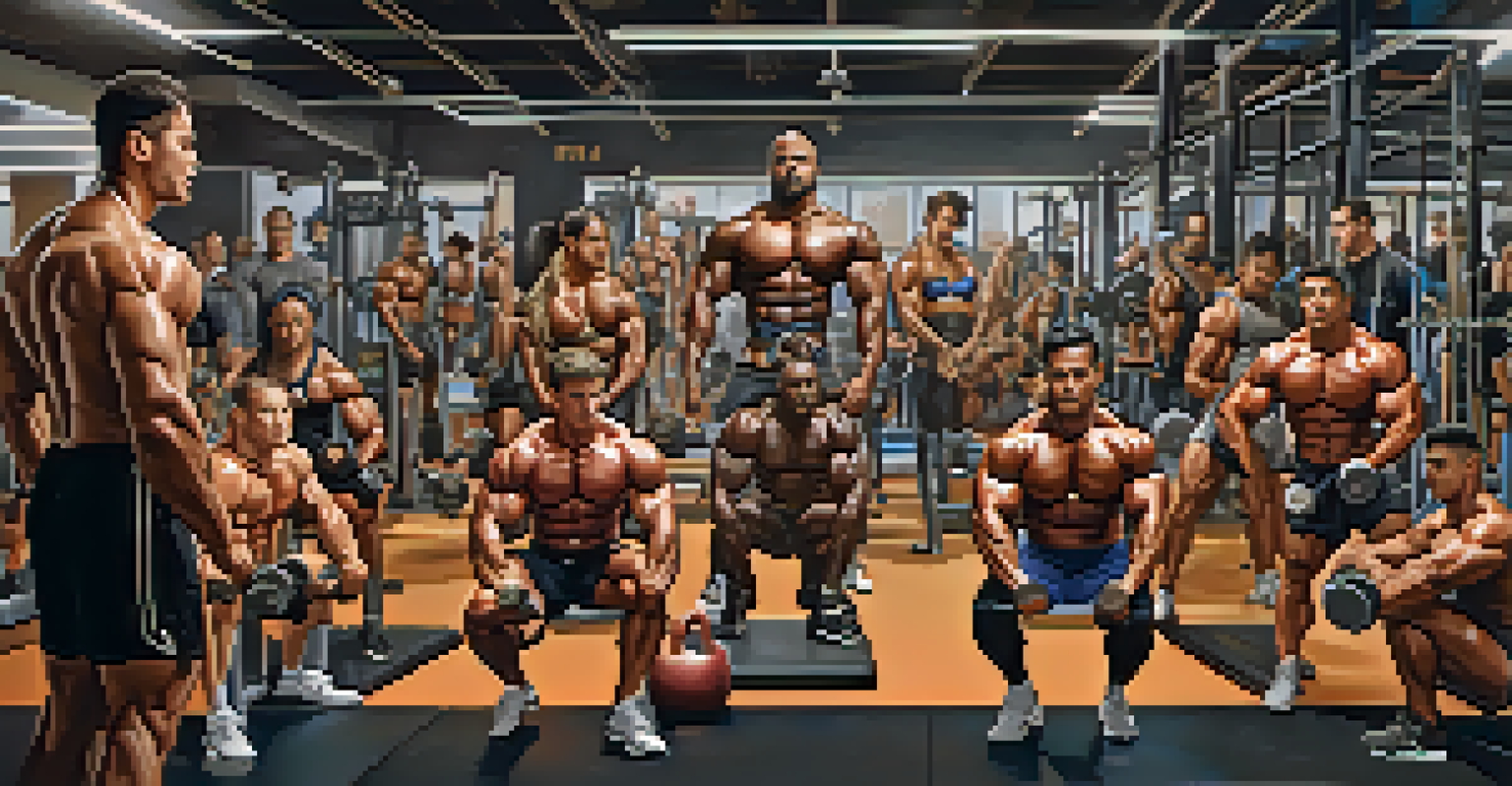The Influence of Western Culture on Global Bodybuilding Trends

The Rise of Bodybuilding in Western Culture
Bodybuilding has deep roots in Western culture, particularly in the United States, where it gained popularity in the mid-20th century. Icons like Arnold Schwarzenegger and Lou Ferrigno turned bodybuilding into a mainstream pursuit, inspiring millions. This cultural shift highlighted the importance of physical appearance and strength, reshaping societal norms around fitness and health.
The body is a sacred garment.
As bodybuilding grew, it became more than just a sport; it transformed into a lifestyle. The emergence of fitness magazines, competitions like Mr. Olympia, and the rise of gym culture further solidified its place in Western society. These platforms not only celebrated bodybuilders but also educated the public about nutrition, training regimes, and the benefits of fitness.
The impact of Western bodybuilding culture extends beyond its borders, influencing fitness enthusiasts worldwide. As people across the globe adopt Western ideals of strength and aesthetics, they often emulate the training methods and dietary habits popularized in the West.
Global Adaptation of Bodybuilding Techniques
Bodybuilding techniques developed in the West have been widely adopted around the world, from Eastern Europe to Asia. The introduction of weightlifting equipment and training programs, initially made popular in the West, has become standard in gyms globally. This accessibility has allowed aspiring bodybuilders to train using methods that have been honed over decades.

Moreover, the rise of social media has played a significant role in disseminating these techniques. Platforms like Instagram and YouTube allow bodybuilders from all corners of the globe to share their workouts and tips, creating a virtual community that transcends borders. This exchange of knowledge fosters a sense of belonging among fitness enthusiasts, regardless of their location.
Bodybuilding's Cultural Evolution
Bodybuilding has transformed from a niche sport into a mainstream lifestyle, influencing fitness norms and societal ideals of strength.
However, while Western techniques dominate, many cultures have adapted these methods to fit their own traditions and values. For instance, some regions incorporate local forms of physical training, blending them with Western bodybuilding practices to create unique hybrid approaches.
The Role of Media in Shaping Bodybuilding Trends
Media has played a crucial role in shaping the perception of bodybuilding, promoting ideals of strength and masculinity. Films like 'Pumping Iron' and reality shows such as 'The Ultimate Fighter' have glamorized the sport, attracting new followers and participants. This visibility has helped normalize bodybuilding as part of mainstream fitness culture.
Strength does not come from physical capacity. It comes from an indomitable will.
Additionally, fitness influencers and online coaches have emerged as significant figures in this space, often drawing inspiration from Western bodybuilding culture. Their reach extends far beyond local communities, influencing global trends in workout routines, diet plans, and supplementation. This phenomenon showcases the power of media in spreading Western ideals of fitness.
However, this media influence also poses challenges, as it can create unrealistic expectations regarding body image. The pressure to achieve a certain physique can lead to unhealthy practices, underscoring the importance of promoting a balanced approach to fitness.
Cultural Exchange: Bodybuilding Meets Local Traditions
As Western bodybuilding culture permeates different regions, a fascinating cultural exchange occurs. Local traditions often intermingle with Western practices, resulting in unique bodybuilding styles. For instance, in some African nations, traditional dance movements are integrated into strength training, celebrating both heritage and fitness.
This blending of cultures not only enhances the training experience but also encourages inclusivity. Bodybuilders from different backgrounds can share their stories and techniques, fostering a sense of community and mutual respect. This cultural exchange enriches the bodybuilding landscape and demonstrates the adaptability of fitness practices.
Global Adoption of Techniques
Western bodybuilding techniques have been embraced worldwide, with local adaptations creating unique hybrid training methods.
Moreover, this adaptation highlights the importance of respecting local customs while embracing global influences. By acknowledging and incorporating local traditions, bodybuilding can become a more holistic pursuit that celebrates diversity.
The Impact of Bodybuilding Athletes as Cultural Icons
Bodybuilders have become cultural icons, especially in the Western world, influencing trends in fitness and lifestyle. Athletes like Dwayne 'The Rock' Johnson and Jay Cutler have achieved celebrity status, bringing attention to bodybuilding as a viable career path. Their success stories resonate with fans, motivating many to pursue bodybuilding seriously.
These athletes often serve as role models, promoting not just muscle growth but also mental resilience and discipline. Their journeys highlight the dedication required to excel in bodybuilding, inspiring others to adopt similar lifestyles. This influence extends beyond the gym, impacting fashion, nutrition, and even mental health discussions.
As a result, the image of the bodybuilder has evolved from a niche athlete to a mainstream figure, further embedding bodybuilding into global culture. This shift has contributed to a broader acceptance of fitness as an integral part of everyday life.
Challenges Faced by Bodybuilders in Different Cultures
Despite the growth of bodybuilding, athletes in various cultures face unique challenges. In some regions, societal pressures and expectations may hinder individuals from pursuing bodybuilding openly. Cultural stigma around weightlifting and muscular physiques can create barriers for aspiring bodybuilders, limiting their participation.
Additionally, access to quality training facilities and resources varies significantly around the world. In many developing countries, the lack of properly equipped gyms and knowledgeable trainers can stifle the growth of bodybuilding as a sport. This disparity highlights the need for greater investment in fitness infrastructure globally.
Media's Influence on Bodybuilding
The rise of media and social platforms has glamorized bodybuilding, shaping trends while also presenting challenges related to body image expectations.
Furthermore, bodybuilders often confront issues related to nutrition and supplementation, especially when local diets do not align with bodybuilding needs. This challenge emphasizes the importance of education and community support to help athletes navigate their unique circumstances.
The Future of Bodybuilding in a Global Context
The future of bodybuilding is poised for exciting developments as global trends continue to evolve. With the world becoming increasingly interconnected, the exchange of ideas and practices is likely to flourish. This interconnectedness can lead to innovative training techniques and dietary approaches that blend the best of Western and local practices.
Moreover, the growing emphasis on health and wellness suggests that bodybuilding will gain further popularity as more people prioritize fitness. As societal attitudes shift towards holistic well-being, bodybuilding may be embraced not just for aesthetics but for overall health benefits.

Ultimately, the future of bodybuilding lies in its ability to adapt and evolve while respecting cultural diversity. By fostering an inclusive environment that celebrates various approaches to fitness, bodybuilding can continue to thrive on a global scale.